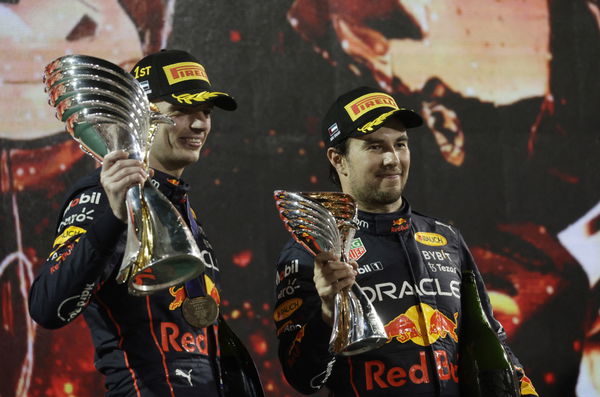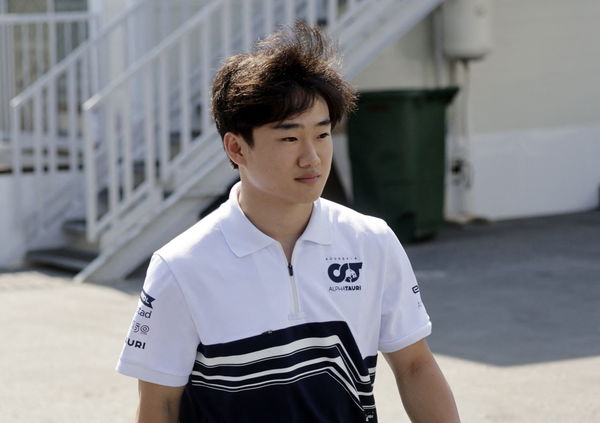
via Reuters
Formula One F1 – Azerbaijan Grand Prix – Baku City Circuit, Baku, Azerbaijan – June 12, 2022 Red Bull’s Max Verstappen after winning the race with second place Red Bull’s Sergio Perez and third place Mercedes’ George Russell REUTERS/Hamad I Mohammed

via Reuters
Formula One F1 – Azerbaijan Grand Prix – Baku City Circuit, Baku, Azerbaijan – June 12, 2022 Red Bull’s Max Verstappen after winning the race with second place Red Bull’s Sergio Perez and third place Mercedes’ George Russell REUTERS/Hamad I Mohammed
2023 will see a wide array of changes in drivers’ lineup as many drivers jump ship. There will also be three rookies that will start their careers at the pinnacle of motorsport. With each driver comes their unique racing number and with each racing number comes a story. Let us have a look at the racing numbers F1 drivers have chosen and the reasons behind them.
Watch What’s Trending Now!
ADVERTISEMENT
Article continues below this ad
In 2014, Formula 1 decided to make drivers’ racing numbers permanent. This was a move to make recognition of the drivers easier for the fans. Before the 2014 season, drivers were assigned numbers based on the position they finished in the drivers’ championship the previous year. The only number that remains up for grabs each season is #1 and can only be had by the reigning champion.
ADVERTISEMENT
Article continues below this ad
What numbers will the Red Bull drivers sport?
Winning the drivers’ championship in 2021, Max Verstappen opted for #1 in 2022. The Dutchman remains firm in his decision to continue with the number in 2023, having won the championship in 2022. Before this, he sported #33. Max used the number #3 in his youth and wanted to continue with it when he joined F1. However, because the number was already in use by Daniel Ricciardo, he opted for #33.
As for his choice of #1, as per Autosport, he told, “How often do you get the chance to drive with starting number 1 in your Formula 1 career? You never know.”
“I can always go back to number 33 if I am no longer world champion. But as long as I am world champion, I will use number 1 every single year.”
ADVERTISEMENT
Article continues below this ad

via Reuters
Formula One F1 – Abu Dhabi Grand Prix – Yas Marina Circuit, Abu Dhabi, United Arab Emirates – November 20, 2022 Red Bull’s Max Verstappen celebrates with the trophy on the podium after winning the Abu Dhabi Grand Prix alongside third placed Red Bull’s Sergio Perez REUTERS/Leonhard Foeger
His teammate Sergio Perez runs with number #11 and the origin story behind it lies in soccer. Having been a huge Club America and their legendary player Ivan Zamorano’s fan, Checo replicated his shirt number for his racing number.
“I liked how Bam-Bam played, how he scored. I became a fan of his and decided to race with that number. To this day I’ve always used #11 everywhere, right down to my email address!” Checo said.
Ferrari drivers’ racing numbers and their origin story
Carlos Sainz drives with number #55. The Spaniard wanted to use #5, but it was already in use by Sebastian Vettel. On the significance of the number, Sainz told, “The S of my first name is like a 5 and so is the S of my last name, so that makes #55.”
Charles Leclerc initially wanted to use number #7 as it was the product of his birth date 16 October 1997. However, the number was taken by Kimi Raikkonen. His second preference was #10, but that was taken as well by Pierre Gasly. Therefore, Charles had to settle with #16.
The story behind Mercedes drivers’ racing numbers
Lewis Hamilton has raced with #44 ever since his karting days. Even after winning the drivers’ championship 7 times, he did not opt for the #1. The origins of #44 lie in Lewis’ dad’s car, which had the License Plate with F44 on it. The Briton has built quite a career with the number and does not look like he will change it any time soon.

via Reuters
Formula One F1 – Brazilian Grand Prix – Jose Carlos Pace Circuit, Sao Paulo, Brazil – November 12, 2022 Mercedes’ George Russell and Mercedes’ Lewis Hamilton wave to fans after finishing in pole position and third place in sprint qualifying REUTERS/Amanda Perobelli
His young teammate George Russell sports the number #63. The story behind the number is pretty simple. George revealed, “My brother used to kart with the number 63, so this has become our family number ever since.”
The reason is in contradiction to what some believed it to be. People thought George used the number 63 because it looked a bit like GB, short for Great Britain.
The numbers that Alpine’s French drivers sport
Esteban Ocon won his first karting championship in 2007 with the number #31. Ocon drove in his F1 test debut for Lotus in 2014 with the same number. He has stuck with the number and will continue with it in 2023.
Read More: How Does F1 Qualifying Work?
Pierre Gasly is a huge fan of former French soccer player Zinedine Zidane. Zidane used to play with jersey number 10 and that inspired Gasly to take it up as his racing number. He even won the Formula Renault 2.0 Eurocup with the number in 2013.
The no-origin stories behind McLaren drivers’ racing numbers
Oscar Piastri is set to replace his countryman Daniel Ricciardo at McLaren in 2023. The Australian driver will use the number #81 in Formula 1. Oscar used to drive with number #11 during his early karting days back home. As he progressed in the karting scene, #11 was already taken and he had to switch to #81. He kept changing his racing numbers in different series but returned to #81 when he competed in British F4 and the Formula Renault Northern European Cup.

via Reuters
Formula One F1 – Abu Dhabi Grand Prix – Yas Marina Circuit, Abu Dhabi, United Arab Emirates – November 20, 2022 McLaren’s Lando Norris ahead of the race REUTERS/Leonhard Foeger
His teammate Lando Norris simply uses #4 because it simply goes well with #L4ndo. “The story is that there is no story. It fits well with the hashtag #L4ndo, but it’s not a number I’ve used in all racing classes,” he revealed.
The Alfa Romeo drivers’ racing numbers
Alfa Romeo’s Zhou Guanyu sports the number #24 in Formula 1. Being a big fan of NBA legend Kobe Bryant, the choice was a no-brainer as Kobe played with the same jersey number.
Zhou’s teammate Valtteri Bottas wanted to take up lucky number #7 but it was already taken by his fellow Finnish driver Kimi Raikkonen. Valtteri simply repeated the number to take the racing number #77. He even sells his merch with the brand logo Bo77as.
The superstitious stories behind Aston Martin drivers’ racing numbers
Fernando Alonso became the karting world champion on 14 July 1999, at the age of 14. Moreover, the Spaniard sported #14 that year. “From that moment I knew #14 was my number,” Fernando told. Staying with the number, Alonso sports it in Formula 1. How many coincidences could there be?

via Reuters
Formula One F1 – United States Grand Prix – Circuit of the Americas, Austin, Texas, U.S. – October 20, 2022 Alpine’s Fernando Alonso during a press conference ahead of the United States Grand Prix REUTERS/Mike Segar
His teammate Lance Stroll won the Italian Formula 4 Championship with number #18. Soon after his 18th birthday, Stroll made his debut in F1 with Williams. Since then, he has stayed firm on it. He said, “A bit superstitious, but I like to hold on to little things that are important to me. I don’t want to change them.”
Haas drivers’ racing numbers
Kevin Magnussen won the 2013 Formula Renault 3.5 series with #20, which he continued with the next year when he made his F1 debut with McLaren. He continues to use the number since then.
His new teammate, Nico Hulkenberg will replace Mick Schumacher next year. The German driver will make a comeback with the number #27, which is the addition of his birth date 19 August.
AlphaTauri drivers’ race numbers and the stories behind them
Yuki Tsunoda raced in his karting days with the number #11. The Japanese driver wanted to carry the number with him as he progressed to Formula 1. However, the number was already taken by Sergio Perez. Therefore, he simply doubled the number and races with #22.

via Reuters
Formula One F1 – Azerbaijan Grand Prix – Baku City Circuit, Baku, Azerbaijan – June 9, 2022 AlphaTauri’s Yuki Tsunoda ahead of the Azerbaijan Grand Prix REUTERS/Leonhard Foeger
His teammate, a new entrant on the grid, Nyck de Vries, wanted to start with #17. However, F1 has retired the number as it was used by Jules Bianchi, who tragically passed away after a fatal crash during a race. De Vries will race with #21, the number he won the Formula E championship with.
Williams drivers’ aspirational racing numbers
Ever since his debut for Toro Rosso in 2019, Alex Albon has stuck with the number #23. Being a fan of Valentino Rossi, who raced with #46, he simply halved the number and made it his own. He explained, “I’ve always been a Rossi fan but since I can’t replace the doctor himself, I thought I’d have half of it.”
The new entrant and Nicholas Latifi’s replacement Logan Sargeant will sport the number #2. Having had a successful campaign with the number during his Formula Renault days, he intends to keep the run going. He initially wanted #3, but because it was already taken by Daniel Ricciardo, Logan opted for #2.
Watch This Story: F1 Drivers That Don’t Live In the Tax-Heaven Monaco
Which driver’s racing number and its story impressed you the most? Do let us know.
ADVERTISEMENT
ADVERTISEMENT
ADVERTISEMENT
ADVERTISEMENT


